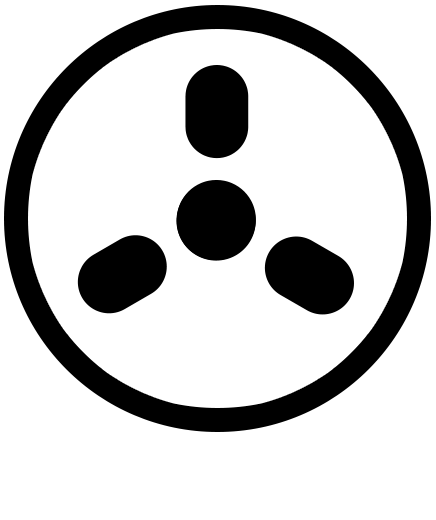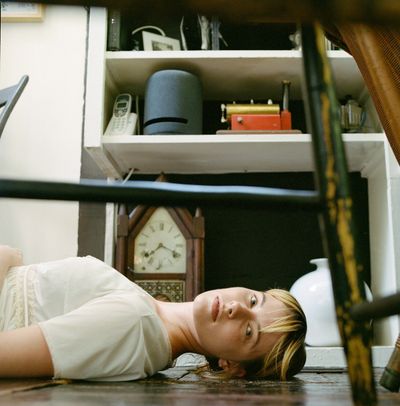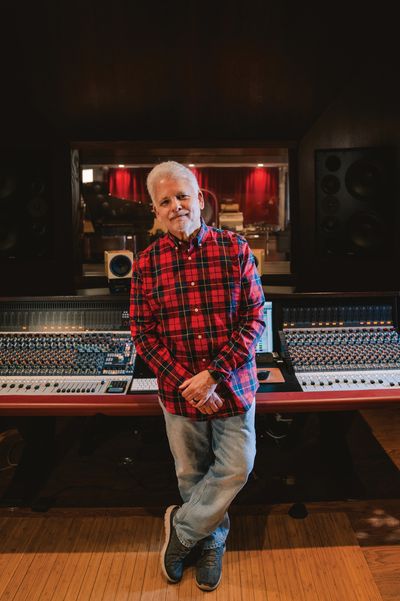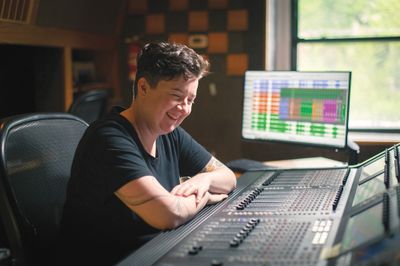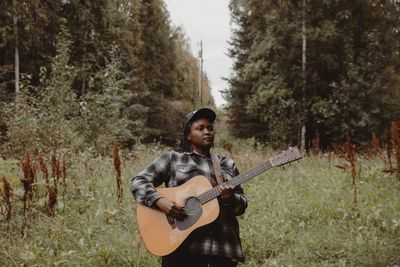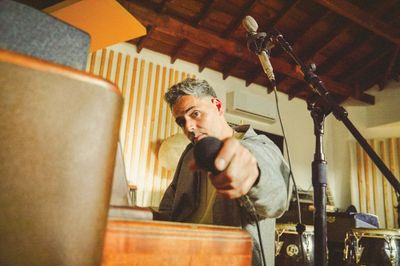Can you describe your evolution from largely self-produced/self-engineered work to your current arrangement with different co-producers?
Yeah. I didn't know anything going into it. I had an [Avid] Mbox, just one mic, and whatever borrowed gear I could find from friends. I started it in upstate New York with just demoing and making things – finding what felt good. I wasn't interested in high fidelity. I wasn't interested in anything other than making it feel exciting and playful and creative. I finished the first record when I moved to L.A. and I magically moved into this house where King Tuff [Kyle Thomas] used to live – the same room that he lived in, which I didn't even know until later. At the house, there was all this music gear in the basement that belonged to the guy who owned the house. It wasn't a lot of nice gear, just some microphones, clip-on snare mics, and some cables, and this beautiful acoustic guitar – beater, nylon guitar – that I fell in love with. Then, during the finishing of that process, since I didn't have much experience in studios or recording other than one channel, one preamp, one thing happening at once, there would be some days where I'd be getting some crazy buzz happening. I would spend four hours diving on the internet like, "Oh, is it a ground thing? Is it the power? Is my mic broken?" I would take the mic apart. Or, "Is my cable broken?" Then I'd get a new cable. And then I'd realize that the cable wasn't plugged into the fucking interface.
[laughs] You've got to love that!

That would lead me to not think about the music that I was making, because my brain would switch into troubleshooting tech with very little experience, knowledge, or resources other than the internet. That was almost eight years ago. Sometimes, even now, after having made so many more records and been a session musician for so long, half of the battle is figuring out what to search for. I'm grateful now that I can call somebody who has the knowledge and a studio, or, in my current situation, go upstairs [to ask my roommate]. With Wildly Idle, I got frustrated with how much time it took to think about whether I was getting a sound that was fitting the emotion of a song. And it's a lot of computer time, because I don't have an analog studio. For placeholder, I was lucky enough to [have met] my friend, Brad Cook [Tape Op #156], who co-produced the record, and we went to April Base in Wisconsin, which is our friend Justin Vernon's [Bon Iver] studio. I worked with Chris Messina and Zach Hanson on that record, and it was the first time that I had people doing the recording. For Fun House, Kyle [King Tuff] engineered it and Sasami produced it; we all had been living together in the pandemic. We would sit down and think about what we wanted the palate to be. We liked the sound of [Fleetwood Mac's] Tusk and how there's a lot of dryness. With Wildly Idle, the thing that I did a lot was add reverb, because it was my first record. I would not even put a plug-in on a bus, I'd just drop it in on the channel. My computer crashed and I'd have to restart it – inefficient, but also very real and true to the way that I entered recording and what excited me. I was writing the songs in my bedroom where everything is quiet and sitting close to the microphone. I couldn't really gain stage that much without cranking the noise floor. I started writing songs at soundcheck, so the songs needed more headroom. I was performing them and writing them in a different way, so they needed to be recorded in a different way. Then, with Sugar the Bruise, I wanted it to sound really hi-fi, and Panoramic [House] was a great place to do that. The first time I went to that studio and met John [Baccigaluppi], who co-owns it and runs it, was with Kevin Morby. I remember going there and recording City Music as a band member, and feeling, "Wow, it would be so cool to come back here and make my own record." I had never had access to that up until moving to California and meeting these people who have studios. Now my favorite thing is letting somebody whose passion is capturing sound in a way that enhances the emotional content of a song [do that]. Now I know that's not where my passion is, first and foremost, but it's a symbiotic relationship. Philip Weinrobe has inspired me so much; he talks a lot about efficiency, but in a way that is coming from the heart. That, to me, is my language: I'm a heart person. When we mixed, I gave him all of these tracks that were unfinished and he finished them by doing some muting, spatial processing, and re-amping – or re-running it through his gear at home and touching some different circuits. I wanted these songs to give goosebumps. So many times, I've had goosebumps while performing, and then I'll listen back, and there's something lost. But there are people who are good at capturing that, and making it translate.
You've mentioned being more the emotional content/writer/composer/"heart" person. Are there aspects of the recording process that you feel drawn to or feel capable of doing?
I'm still learning what those are, and it's situational. When it comes to my own music, it gets confusing because my heart is in it. It's hard to know sometimes what's best objectively. We all hear our own voice so differently – because of resonators, because of vulnerability, and because of bias. In the studio with my own music, I've learned that I don't know what's best for my own vocals. But I do know that I'm good at instrumentation and I'm good at knowing when to mute things. I'm good at knowing when less is more. I've learned that from Wildly Idle, where it was never less-is-more. It's so dense and muddy. I'm good at knowing when to take a break – and, again, I think I've learned that from not taking breaks. I'm learning how to sense when my perspective is skewed from exhaustion, hunger, or something like that. Then, from the technical side, I'm good at knowing when it can be better, and when sometimes better means not "high quality." I'm good at knowing when a recording is lacking some human nature, or when it feels too perfect. A lot of what draws me into recordings is the tactile, the room sound – and I don't mean the "room sound," just the sounds that are in the room. At Panoramic, where I did Sugar the Bruise, the live room is basically a living room that is so gorgeous and overlooks the ocean. I'm so spoiled that I even get to go there. If it's raining, you're hearing the rain. There's a huge glass window; it's not a treated live room. If it's hot, the rafters will crack. I used to think that those were the sounds that you needed to edit out. A lot of what makes recordings that I gravitate towards interesting for me is because something is a little off – raw and accessible and relatable.
That makes a lot of sense. You've mentioned improvisation as being fundamental to your process as an instrumentalist and songwriter. Is this something that can show up for you in the recording space?

Absolutely. Especially when it comes to guitar. I don't write guitar parts for my pieces until I'm in the studio and, for me, the most exciting and valuable moment to record is before I know the song – and if I know it's not recording. In lockdown when everybody was doing remote recording, I got to see that. I was asked to do all these [remote] sessions. For the Weyes Blood record [And in the Darkness Hearts Aglow], I spent all day developing a part, and she [Natalie Mering] ended up using the first thing I sent over. That happens so much, and it's so easy to lose the plot of musicality when trying to perfect something. There are so many stories, with classic albums, where they say, "We played the song 100 times and then used the first take." Then there's a lot of improvisation, in terms of mic placement, amp use, or where a sound is coming from – having these happy accidents happen. We've improvised using a mono mic for a drum set, like, "Oh shit, that mic that we had for the amp cab in the same room as the drums was going while we were tracking drums," and we end up using that mic because it has this quality that I don't think we could have planned for. For Sugar the Bruise, I think it was "Gift of the Human Curse" where we had already tracked the "Something Wrong" guitars. We had done a quadrophonic amp situation to try to get different tones in a spatial array. We were experimenting and having fun and didn't think too much about it. I just thought, "I have this Magnatone and this [Fender] Princeton, and they sound good together." Then Jeremy [Harris, producer] said, "Let's try to go quad," so we set up two more amps. There was this one drum part that comes in really brushy, and it didn't sound good when it was close mic'd. It was losing some of the dreamy quality of the song, so] we ended up using a combination of the [bleed into the] amp mics that were adjacent to the drum set. I've had so many situations like that in the studio, where it's an accident; we're improvising, or we're trying something that might not work. It's taken me a long time to learn that, because in studios growing up, I would always assume that everybody knows everything and I don't, that there's some wisdom that they know that I don't have access to, so I would blindly trust. But, as I developed more relationships with people, the biggest piece of advice that I've gotten is, "Just try something." Even with gain staging. If it was in the yellow, I thought that that was bad, and I'd be scared. I was talking to King Tuff/Kyle the other day about parallel compression and mix busses, and he was like, "Don't be scared. Here's the template. Try some stuff and see if it sounds cool." Inherently, I have a funny mix of not wanting to break the rules – wanting to do it right and do a good job. But I'm also anti-authority, so I'm like, "Well, that's fucking stupid. I don't want to do that just because this guy on a preset, (whom I've never heard of) says that's the way you're supposed to do it." When I took the one engineering class that I took in college, I wish that somebody had said, "Here's access to a studio. Go crazy. Then we'll teach you ways to make it sound closer to how you want it to sound."
That's so interesting. It's like, "Screw you. I don't want your template... but I also crave structure."
Yeah, exactly. "I want your template, but I want permission to change it."
What are some new pieces of recording equipment, plug-ins, or techniques that co-producers have turned you on to?
Soyuz mics. I recently met Scotty [Iulianelli], who works for them, through a friend who owns a studio in New York, Thump Studios. I used them on a session that I had with Nick Sanborn (from Sylvan Esso) and Jenn Wasner. I've incorporated a lot that I've learned from Nick. We were hanging and making music, and we used them on this little tenor ukulele. They are well-made, they look beautiful, and they sound really good. I love the Goodhertz plugins. They're amazing, and [the company has] been super supportive. Plugin Alliance and iZotope have been supportive too. I love the interfaces – especially with Goodhertz. It's so intuitive, and I can simplify it to be just a couple parameters, but then expand it and get a little deeper. Then there's a thing that Luke [Temple] did: Recording at half speed, then printing it again at regular speed [to] change the quality of the recording. That was fun. We did that quite a bit on Sugar the Bruise, and I'm excited to try that on my own. So much of my experience has been meeting these amazing, interesting people who love music and want to help, and that is something I've been thinking about, in terms of recording. So much of my journey has been by accident, by grace, or something – getting lucky to meet these interesting people who all are interested in music and are involved in many ways. I don't often retain a lot of the technical information when it comes to transistors, diodes, or capacitors. But I am interested in passion, and I think that that's where I intersect with a lot of these technical builders – like my friend Jesse [Honig of Believable Audio] who makes the Euna [Elite Unity Amplifier Pedal]. I'll go over to their shop, listen to them talk about what they're doing, and it's so mysterious to me in the same way that making songs is mysterious to people who make microphones.
